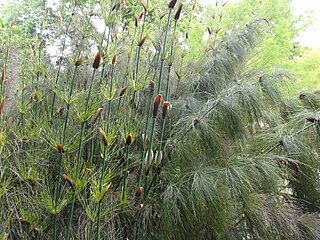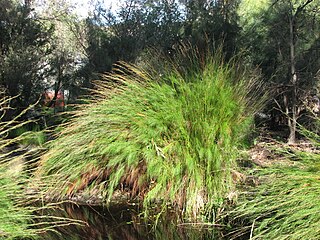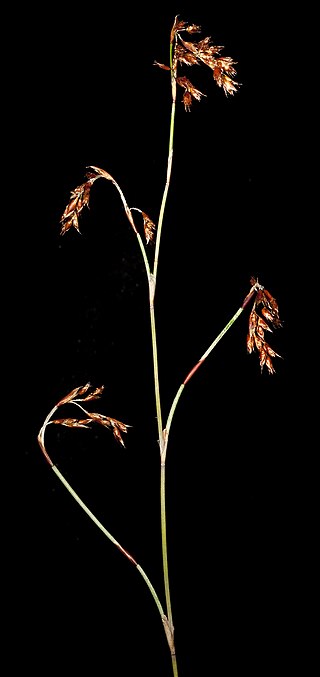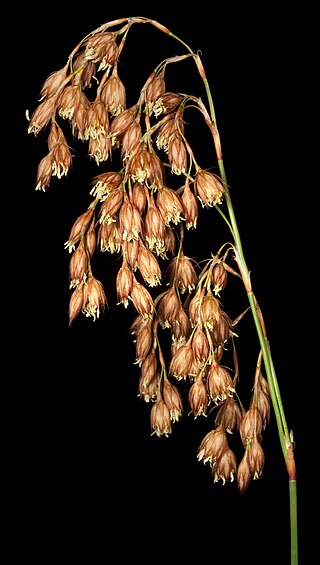
The Restionaceae, also called restiads and restios, are a family of flowering plants native to the Southern Hemisphere; they vary from a few centimeters to 3 meters in height. Following the APG IV (2016): the family now includes the former families Anarthriaceae, Centrolepidaceae and Lyginiaceae, and as such includes 51 genera with 572 known species. Based on evidence from fossil pollen, the Restionaceae likely originated more than 65 million years ago during the Late Cretaceous period, when the southern continents were still part of Gondwana.

Harperella is a monotypic genus of flowering plants in the family Apiaceae. Its only species is Harperella nodosa, known as piedmont mock bishopweed and harperella. It is native to riparian environments in the Southeastern United States, found at sites in West Virginia, Maryland, several Southeastern states such as Alabama and North Carolina, and the Ouachita National Forest in Arkansas and Oklahoma. As Ptilimnium nodosum, it was placed on the United States' Endangered Species List in 1988.

Darwinia, sometimes commonly known as mountain bells or simply bells, is a genus of about 70 species of evergreen shrubs in the family Myrtaceae, endemic to southeastern and southwestern Australia. The majority are native to southern Western Australia, but a few species occur in South Australia, New South Wales and Victoria. The genus was named in honour of Erasmus Darwin, grandfather of Charles Darwin by Edward Rudge in 1816. Most darwinias grow to a height of between 0.2 and 3 m, and many are prostrate shrubs. Most have small, simple leaves and the flowers are often grouped together, each flower with five red, white or greenish petals and ten stamens. In many species, the flowers are surrounded by large, colourful bracts, giving rise to their common names.

Xylomelum is a genus of six species of flowering plants, often commonly known as woody pears, in the family Proteaceae and are endemic to Australia. Plants in this genus are tall shrubs or small trees with leaves arranged in opposite pairs, relatively small flowers arranged in spike-like groups, and the fruit a woody, more or less pear-shaped follicle.

Cocklebiddy is a small roadhouse community located on the Eyre Highway in Western Australia. It is the third stop after Norseman on the journey eastwards across the Nullarbor Plain. Like other locations in the region, the site consists of little more than a roadhouse. The current business name of the roadhouse is the Wedgetail Inn and, like most other Nullarbor establishments, has access to satellite television, as well as providing caravan park and hotel-motel facilities.

Acidonia microcarpa is a species of shrub in the plant family Proteaceae. It is the only species in the genus Acidonia. It is endemic to the south coast of the Southwest Botanic Province of Western Australia.

Apodasmia is a group of plants in the Restionaceae described as a genus in 1998. It is native to Australia, New Zealand, and Chile.
Hypolaena is a plant genus in the family Restionaceae, described as a genus in 1810. The entire genus is endemic to Australia.

Baloskion is a genus of rush-like plants from Australia.

Leptocarpus is a genus of dioeceous rush-like perennial plants described as a genus in 1810.
Dielsia is a genus of flowering plant, described in 1904, in the family Restionaceae. There is only one known species, Dielsia stenostachya, endemic to Western Australia.

Malleostemon is a genus of flowering plants in the myrtle family Myrtaceae, described as a genus in 1983, by John Green The entire genus is endemic to Western Australia.
- Malleostemon costatusRye & Trudgen
- Malleostemon decipiens(W.Fitzg.) Trudgen
- Malleostemon hursthousei(W.Fitzg.) J.W.Green
- Malleostemon microphyllusRye & Trudgen
- Malleostemon minilyaensisJ.W.Green
- Malleostemon nephroideusRye
- Malleostemon nerrenensisRye & Trudgen
- Malleostemon pedunculatusJ.W.Green
- Malleostemon peltiger(S.Moore) J.W.Green
- Malleostemon pustulatusRye
- Malleostemon roseus(E.Pritz.) J.W.Green
- Malleostemon tuberculatus(E.Pritz.) J.W.Green
- Malleostemon uniflorusRye

Chaetanthus is a group of plants in the Restionaceae described as a genus in 1810. The entire genus is endemic to the southern part of Western Australia.
Dapsilanthus is a genus of plants described as a genus in 1998.

Meeboldina is a plant genus in the family Restionaceae, described as a genus in 1943. It is named for the botanical collector Alfred Meebold.
Onychosepalum is a plant genus in the family Restionaceae, described as a genus in 1855.

Chordifex is a genus of plants in the Restionaceae described as a genus in 1998. The entire genus is endemic to Australia.
Winifredia is a group of plants in the Restionaceae described as a genus in 1986. There is only one known species, Winifredia sola, endemic to the Island of Tasmania.

Desmocladus is a genus of herbs in the family Restionaceae, all species of which are endemic to Australia, and found in Western Australia and South Australia. In this genus, the stems are the principal photosynthesizers.

Chordifex microdon is a rush species of the genus Chordifex in the family Restionaceae, native to Western Australia.














